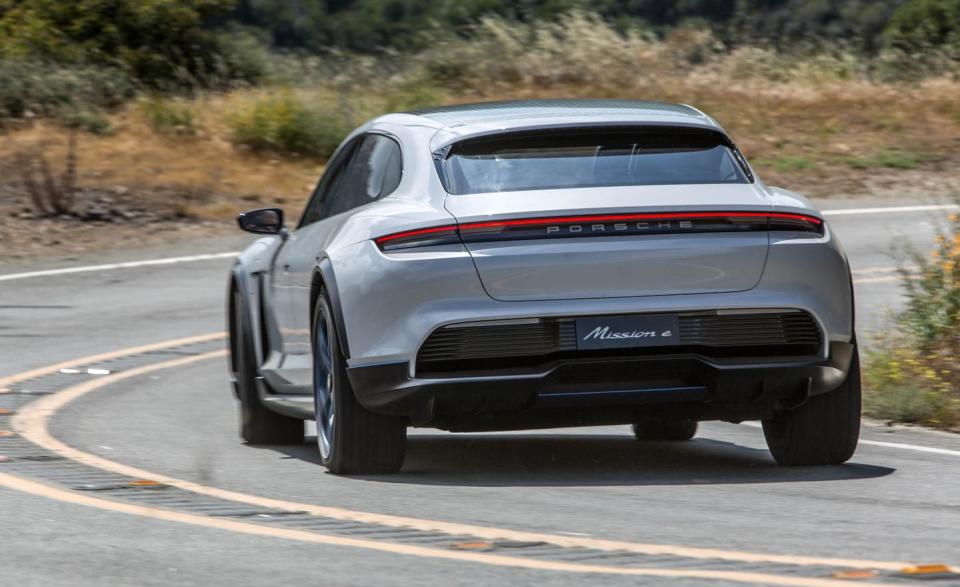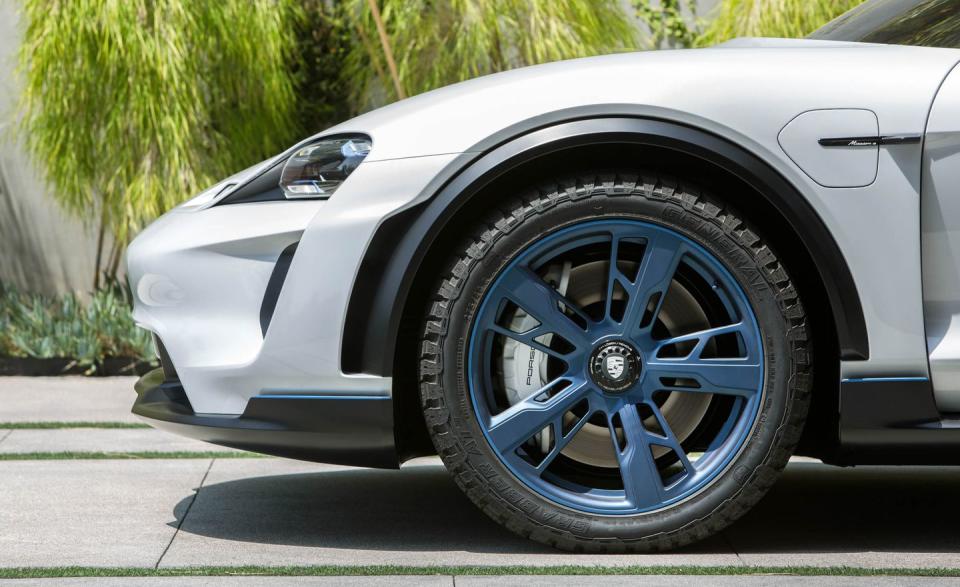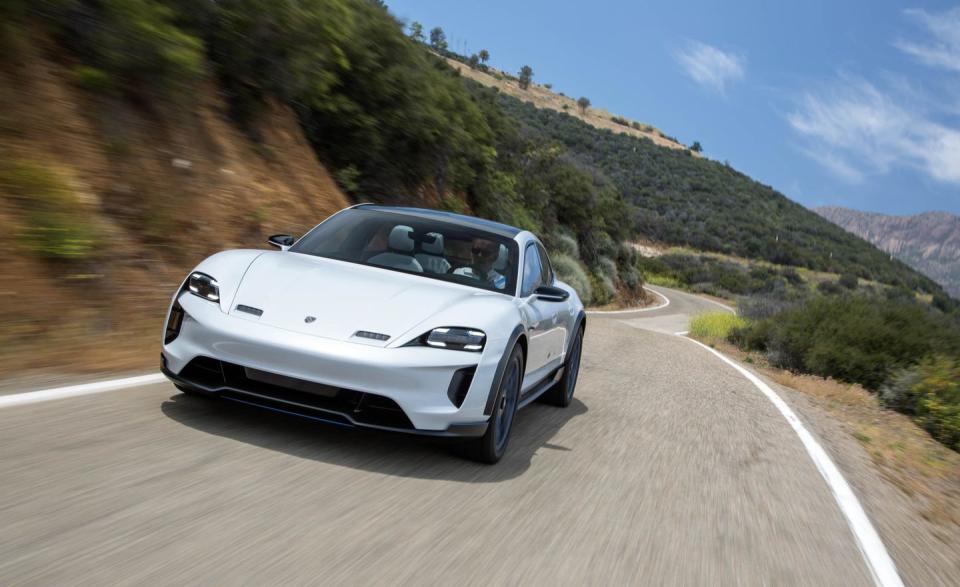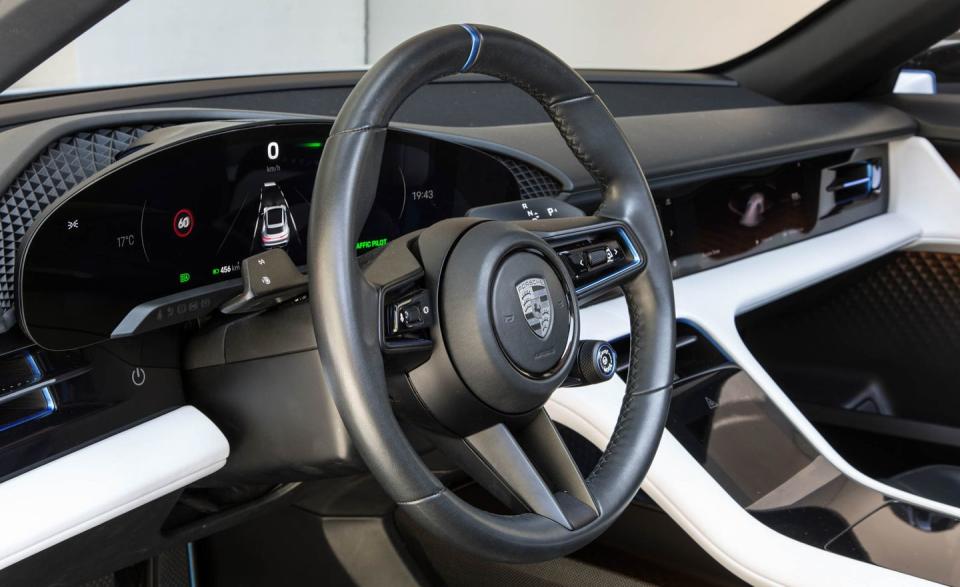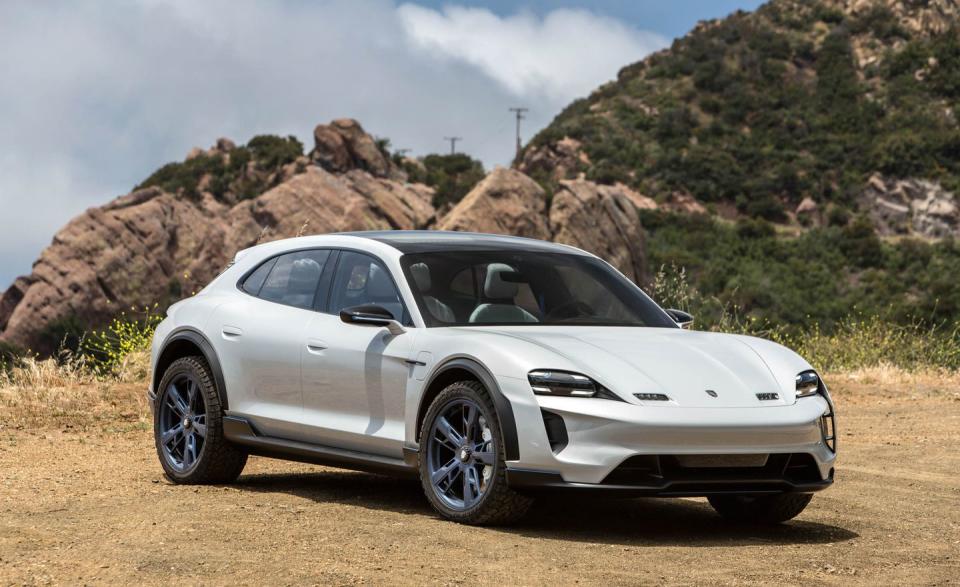We Drive the Porsche Mission E Cross Turismo Concept
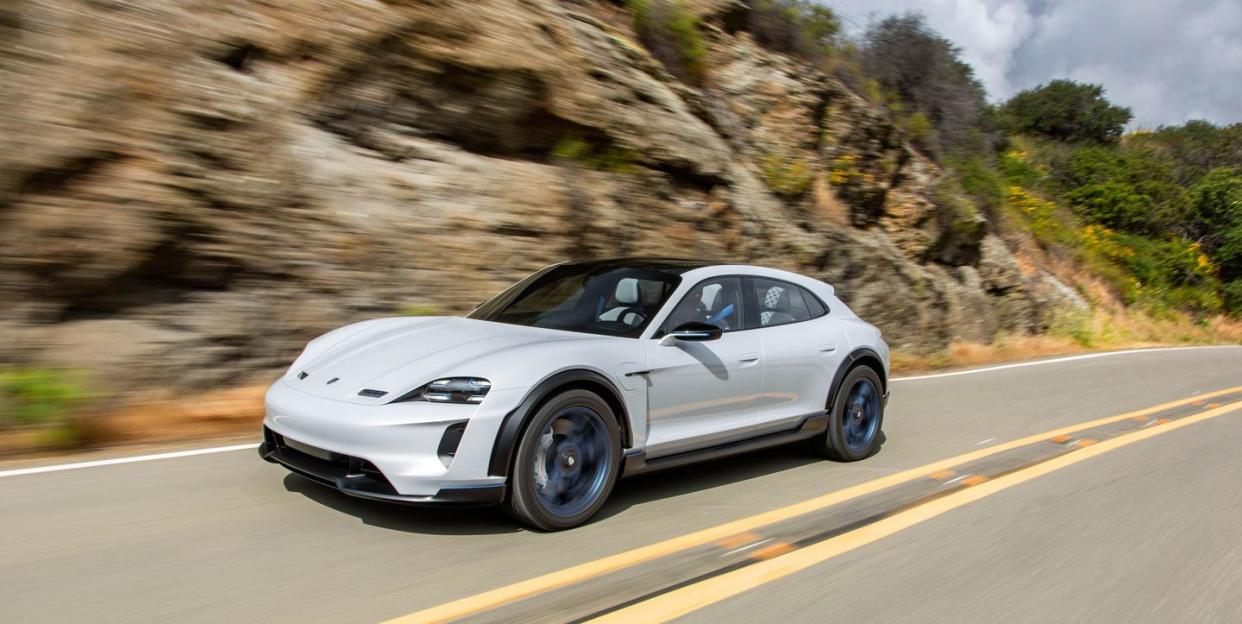
Most concept cars are improbable concoctions with impossibly sexy profiles, impractical packaging, and wildly optimistic performance claims. Porsche doesn’t usually tread in this tall-tale realm, and with its production-bound Mission E project, it has become apparent that the claims it makes for the Mission E concept hew closely to what will be delivered less than a year and a half from now: zero to 62 mph in 3.5 seconds, 600 horsepower, a driving range of 310 miles, and a game-changing charging capability to regain about 250 miles of range in 15 minutes.
Porsche is expected to decide this summer on whether it will build the Mission E Cross Turismo concept, a more outdoorsy activity-wagon version that it showed at the Geneva auto show earlier this spring. To explore its potential, the automaker recently shipped the car to what would be one of the Cross Turismo’s top markets: California, Tesla’s home base.
And Porsche let us drive it. Concept-car drives can feel a bit like piloting a parade float and tend not to reveal much, but this one was different. This concept was built as a drivable car. At its inception, Porsche essentially did a drag and drop of the Mission E project’s hardware in development, so it serves as a snapshot of where things stood about two years into a five-year program.
In production form, Porsche’s electric four-door will ride on its own unique platform-called J1 internally, developed exclusively by Porsche but to be employed in the future by Audi’s e-tron GT and perhaps by Bentley. But the Mission E Cross Turismo already has the 800-volt architecture, which is really Porsche’s secret sauce for achieving the numbers, surrounded by parts lifted from elsewhere in the company’s lineup.
Locked In, in Form If Not Function
The size of the vehicle and its basic proportions were more or less locked into place with the concept. The Mission E sedan and Cross Turismo measure just a few inches shorter than the Tesla Model S, and the Cross Turismo, with its 1.2-inch-higher ride height and roughly 3.5-inch-taller body, adds up to the same 56-inch overall height as a Model S.
The details will differ, but the concept powertrain is an early version of what’s coming. Our driving experience included some asterisks for care and treatment, as outlined by my passenger, Stefan Weckbach, Porsche’s head of electric-vehicle development. The concept-after being originally conceived on tires that were, as Weckbach politely put it, “the designer’s choice”-had to be fitted with aggressively treaded General Grabber AT275/40R-20 tires to work with the packaging and provide the intended off-pavement ability. We were cautioned against hard acceleration out of corners, as tight clearances and the rear suspension geometry could cause the tires to contact the wheel wells. Oh, and we were to stay within a police escort keeping us under roughly 50 mph-that’s a much healthier pace than most concept cars can manage, and we blasted beyond that at least once.
Thus forewarned, we set off in this overweight concept car with handmade bodywork, fixed mirrors, inoperable turn signals, and thinly padded seats that wouldn’t adjust far enough rearward for this tall, six-foot-six driver, and one thing became quickly apparent: this concept doesn’t drive like one.
Even in the first few tight canyon-road corners, the prevailing impression is that the car carries its weight low-very low-with the seat’s hip point right down next to the hefty battery pack. While the center of mass will stay pretty much exactly where it is in production, Porsche has been targeting a 4400-pound curb weight; as it stands, the concept weighs a stout 1320 pounds more than that. Weckbach says that the concept’s electric drive system is delivering “something around 500 horsepower.”
The concept handled well along the canyon road, although the steering felt a little remote, which is out of character for a Porsche. Weckbach assured us that a completely new unit already has been fitted in development mules. “The steering in the series-production car, especially in the coupe, is much different, much more direct,” he said. The brakes are superb in pedal feel in the concept, but there’s very little regeneration dialed in at this point. That, too, is likely to change.
So Many Hints of What’s to Come
We sat behind a functioning gauge cluster, but the rest of what the Cross Turismo strongly hints about Porsche’s future interface isn’t yet operational. The designers aim to give drivers what they need to know without distractions; between a head-up display and the gauge cluster with three different readouts-Commute, Wayfinding, and Workout-the driver can choose how much information the car presents and where. The focus is on paring back the human-machine interface, making it as speech based as possible. But, with a touchpad at the center console, plus touchscreens for communication and entertainment ahead of both the driver and the passenger, there should be plenty of flexibility.
One fantasy feature from the concept that definitely won’t make it to production is the Cross Turismo’s deployable electric drone, which delivers overhead driving video.
Back to reality, we gleaned many more new details about the production car-Cross Turismo or not:
There will be a choice of two battery packs. Based on what Weckbach hinted, we expect the larger one to have around 95.0 kWh of capacity, with a lower one in the vicinity of 80.0 kWh. Peak power will vary accordingly.
The production vehicle will offer an adaptive air-spring suspension, mostly borrowed from the Panamera, to bring its ride height down with speed.
Sound is important. The Mission E won’t sound like a spaceship, but it’s going to sound like, well, an electric Porsche.
It will have a front trunk, or frunk, that’s about the size of the one in the 911.
For the Cross Turismo, Porsche is already talking about a rooftop aerodynamic cargo box, a cargo organizer out back, and a rear-mounted bike carrier. Can you tell they’re leaning toward yes?
Porsche isn’t thinking seriously yet about replacing traditional side mirrors with cameras, unlike Audi with its Europe-market e-tron EV.
Over-the-air updates are definitely a go-more details to come later.
Inductive charging will be offered as a factory option, although not at launch.
Porsche drivers will find the Mission E modes familiar: Range, Normal, Sport, Sport Plus, and Individual. The first one, obviously, is intended to eke out the miles.
The Cross Turismo’s quad headlights are pretty close to the ones that are going to be in the production Mission E. Yes, they can be made DOT legal.
Performance, Performance, Performance
While the long range will be there for normal driving, Porsche insists that the Mission E’s performance credentials on and off the track will distinguish it from other EVs. And to achieve that, the cooling system may well be its ace card. Weckbach wouldn’t yet go into detail, but he described the system as “very complex.” Following our drive at that modest 50-mph clip, with outdoor temperatures in the 70s and 80s, an audible whir of fans continued for some time after we stopped. Weckbach underscored that, unlike the Model S, the Porsche must carry credentials as a true performance car, and that means accommodating full-throttle acceleration runs many times in succession and the ability to maintain its 162-mph top speed for extended periods.
Extreme testing is critical to achieve such goals. For the development team, that has included winter testing in Sweden and Finland, high-heat testing in South Africa, and dynamic tuning at the Nürburgring, Porsche’s home facility in Weissach, a couple of racetracks in Germany, Nardò in Italy, and all the usual places they take their cars. “If you want to have a real Porsche, you need to follow the normal Porsche development procedure, independent of the drivetrain,” he said. Yes, it’s an electric car, but it also has to be a Porsche. And even in the form we see here, it absolutely feels like one.
Porsche Mission E Two-Door and Convertible Possible; RWD Likely
Porsche Planning 500 Very Fast Chargers for Mission E in the U.S.
Porsche has an impeccable record of delivering vehicles that are fully fleshed out on arrival, and that’s exactly what we expect from the production car. It also has a record for holding true to timelines. First deliveries of the sedan will start toward the end of 2019 for Europe and late 2019 for the U.S.
And the Cross Turismo? We have a sneaking suspicion this won’t be the last we see of it.
You Might Also Like
